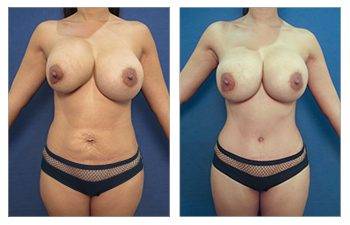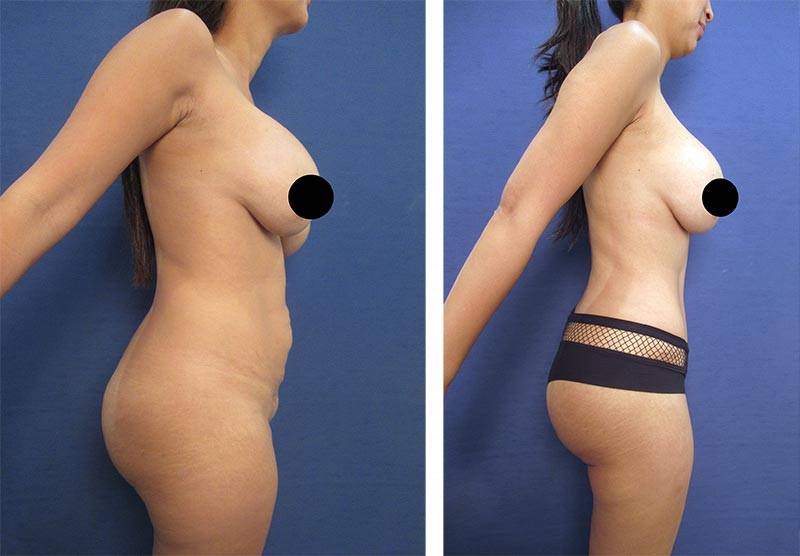

This 36-year-old female patient had a bilateral breast augmentation revision
A woman’s bra size consists of two measurements: the letter cup size (A,B,C, D, DD, etc.) reflective of breast mound volume and an even number (e.g 32, 34, 36, 38, 40, etc.) indicating the band size or measurement around her torso.1 According to Bengston et al., breast mound is measured in centimeters and reflects the horizontal distance over the apex of the breast starting from the medial inflection point where the breast attaches to the chest to the lateral inflection point where the breast attaches to the chest (Figure 1).2 Using this system, 20.0 cm corresponds to a B cup, 21.5 cm corresponds to a C cup, 23.4 cm corresponds to a D cup, and 25.0 cm corresponds to DD cup.2 Next, to measure the band size in inches, a measuring tape is placed below a women’s bust and circumferentially around her rib cage. Using this standardized method, we create the two component measurements (32B, 36D, etc.) that is a woman’s bra size.

Although practical in theory, this method of determining a woman’s bra size is not uniformly implemented by all bra manufacturers and retailers as currently, there is no set international standard for measuring bra size. Demonstrating this are the discrepancies in bra size measurements between popular high end and cost effective bra manufacturers. Using the system described above, a woman with a 20.0 cm-21.5 cm cup size at Calvin Klein and Victoria’s Secret is labeled as a C cup. However, using her same breast mound measurement, she automatically falls under the category of a B cup at her local Walmart and Kmart (ie Warner’s and Bali’s brands). Hence, without reliance on a standardized bra cup size as a guide, women can find it challenging to relay their aesthetic breast goals to their plastic surgeon during their initial consultation. Similarly, with implant sizes being standardized under a different unit of measurement (cc) that is independent of breast cup size, plastic surgeons can find it equally challenging to depict to their patients what their final breast cup size will be following a breast augmentation or breast implant exchange.
Breast implants are described according to four characteristics: size, profile, shape (round), and consistency depending on the medium in which the silicone shell has been filled with (silicone vs saline). With regards to size, breast implants are measured in cubic centimeters (cc) with volumes ranging from 200 cc to 850 cc. How each volume appears on a patient’s habitus is influenced by the implant profile (low, moderate, or high) and the natural anatomy of a patient. As demonstrated in Figure 2, round low profile implants have a wider diameter base and shorter height projection relative to round high profile implants that have a narrow diameter base and increased height projection. Further impacting the final appearance of a breast implant as it sits within a woman’s breast tissue, is the natural variation in female breast sizes, shapes, symmetry, and firmness.

The illustration above demonstrates how a uniform volume of 300 cc results in differences in shape and forward projection among different profile implants.
As bra cup size has been demonstrated to be subjective depending on the bra manufacturer, selecting a desired implant size with the goal of achieving a specific breast cup size aesthetic can be misleading if baseline habitus and personal goals are not clear. Even with concurrent use of breast implant sizers that mimic the actual breast implants, it is important that women have a clear understanding that a comprehensive approach as it relates to their body frame and personal goals is imperative to achieving a desired aesthetic outcome. An implant size that a short and petite woman may consider as “too much”, a taller or larger framed woman may consider as too “subtle” (Figure 3).3

Uniform cup size presented among different body type frames and band sizes.4
Hence, in an effort to convert bra cup size measurements to breast implant sizes, the standardized bra cup size measurement system described above can be used with the unit conversions as follows: Patients with narrower band widths (torsos) can experience an estimated increase in one cup size postoperatively with every 250 cc increment in implant size, while patients with wider band widths (torsos) may require an increase of 300 cc increments to achieve the same one-cup-size increase effect.2 How this increase in volume looks ultimately depends on the patient’s natural anatomy and the characteristics of the implant being used.
- https://theconversation.com/wearing-an-ill-fitting-bra-isnt-just-uncomfortable-its-bad-for-your-health-100292
- Bengtson BP, Glicksman CA. The Standardization of Bra Cup Measurements: Redefining Bra Sizing Language. Clin Plast Surg. 2015 Oct;42(4):405-11. doi: 10.1016/j.cps.2015.06.002. Epub 2015 Aug 13. PMID: 26408432.
- https://www.cupmysize.com/wrong-size-bra/
- https://beldholm.com.au/breast/comparing-ccs-to-bra-cup-size-how-to-choose-the-breast-implants-right-for-you/

Download SurgiSculpt’s free Liposuction eBook
